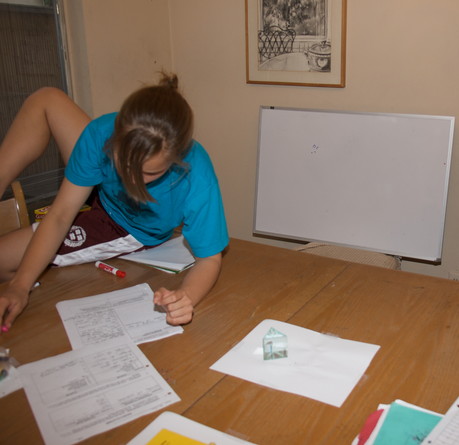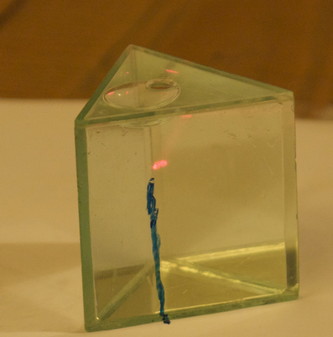Mom! Dad! I need help!
This is why:
A. I support affirmative action
B. I think some kids succeed in math and science while most don’t.
For the past several days, this call has been heard in our house at least once every five minutes,
“Mom! Dad! I need help!”

It is science project time for the sixth grade at St. Anne’s School. This year, the world’s most spoiled twelve-year-old has gotten on sciencebuddies.org and decided to do her project on how the density of a solution can be determined by the index of refraction. Plus, it involves lasers, so it is hard to beat that. So, every five minutes we hear,
“Mom! Dad! I need help!”
“Yes, what is it?”
“I found on the internet that Snell’s Law is sine(theta1) divided by sine(theta2). What’s a sine function?”
So, I sat down with the white board in the living room floor. (WHY do we have a white board on our floor? Who put it there? I don’t know.) and wrote:
y = f(x)
She asked,
“So you multiply f and x, right?”
We realized then that she had only gotten so far in school and to her the notation f(x) meant you multiply f by whatever is inside the parentheses. So, I explained the idea of a function, drew out a linear function, a curvilinear function and a sine function.
A few minutes later,
“Mom! Dad! I need help!”
“Yes?”
“What is theta1 and theta2?”
So, we find an article on wikipedia that explains Snell’s law and has a diagram showing theta1 and theta2. We explain that theta is a Greek letter, that in math people use Greek letters a lot to stand for things. We point out which one is theta1 and which is theta2 on the diagram in the article. Satisfied, she writes up the first part of her science project – her question and hypothesis.
While she’s at work, Dennis gets on line and orders prisms and lasers from MiniScience.com . In an amazing burst of restraint he only orders two prisms and four lasers and nothing else. Realizing we need something to measure density, I walk down to Sur La Table and pick up a measuring cup that has a digital readout in the handle that tells the weight in grams of what you put into the cup.
She spends a good bit of Sunday afternoon setting up her apparatus and taking measurements, the first part of that is messing with the cup, putting in sugar, checking the weight in grams, dumping in water, calculating the percentage. It involves making a mess and not getting yelled at, a combination hard to beat. Calculating ratios and density is secondary. Being only slightly higher on the maturity scale, Dad helps.
Eventually, he holds the laser while she marks the spot it hits on the ubiquitous white board. They repeat this with solutions varying in density.

“Mom! Dad! I need help!”
“What is it?”
“On this paper it says I am supposed to write down which are my dependent and independent variables and which are my controls. Which is it?”
“Well, the thing that you changed would be your independent variable -”
“The density, how much sugar was in the solution. So the independent variable is the thing that changed and the dependent variable is the thing that stayed the same?”
“No, variables change. That’s what vary means, to change…”
A discussion of variables versus constants ensues.
Over the days that Julia works on her science project she learns about math, including trigonometry, measurement in grams and centimeters, refraction and more. She uses the Internet and finds some sites that interest her. She spends a lot of time on sciencebuddies.com , looking at other projects she doesn’t choose. She reads about Snell’s Law and refraction on wikipedia. Does she understand it all, even with explanation? Nope, but she understands a lot more than she did last month. In making her project board, she uses OpenOffice, decides she doesn’t like that and switches to Microsoft Office. She tries the chart feature within PowerPoint, decides that sucks and does her chart in Excel. She learns how to edit a chart in Excel….
“Mom! Dad! I need help!”
“Yes?”
“How do I fix this chart?”
“Right-click on it. Pick select data. Click where it says X axis category labels.”
We have another discussion about X axis and Y axis, categorical data versus numeric data. And so it goes until the project is done. Every year, Julia is required to do a science project because every child at her school is required to do a science project. Similarly, every child in her school takes Algebra in the eighth grade because that is the only math class that is offered. A teacher at a public school district bragged to me recently that her district did the same, every child took Algebra in the eighth grade. I found that fascinating because a few years ago I had done an evaluation for a program at the high school that was addressing the problem that 65% of the NINTH-GRADERS were failing Algebra. So, the solution, apparently, was to teach Algebra in the eighth grade.
This is like back in the 1970s when the solution to children from lower-income families entering kindergarten behind those from middle-class families was to have mobiles over the crib and other accoutrements of the typical suburban nursery.
What Julia has that those children don’t have is both a school that requires more of her and a home environment that provides the support to meet those requirements. There are three computers within reach of where I am sitting, with Unix, Macintosh and Windows operating systems all with either Open Office or Microsoft Office. There is a wireless network in the house. While the stuff makes it easier to do her project, it is not just the stuff and it is not just the requirement to do a science project.
She also has two parents sitting around who are willing (albeit grudgingly at times) to drop what they are doing and explain anything from the concept of f(x) to how to label the X categories on a graph in Excel. While I am writing this, because a documentary on the financial market is on TV, Julia and her father are arguing about economic theories based on rational behavior versus Schiller’s theory of irrational economic behavior. It involves some rather immature discussions of what he might do to the stuffed monkey he is offering to buy from her and tossing of the monkey back and forth.
In the past couple of weeks alone, Julia has probably received 20 hours of tutoring in math and science. Vygotsky would be pleased. Two years from now, she’ll be taking exams to get into high school and I am > 99% sure that she will get into the high school that we have already picked out. Is that arrogant? Nope. With nine years of the advantage of a good private school and day after day of patient (usually!) explanation of functions, sine(theta), X axis, angles of refraction and more I expect she will do well. Currently, she also has an older sister in the house who was a history teacher and is living at home while she finishes her masters. She makes sure to check Julia’s social studies homework and quiz her on that.
Why am I in favor of affirmative action? Because I am not stupid. The world’s most spoiled twelve-year-old has had years of individual tutoring, just about every resource money can buy and excellent, caring teachers every single day. I realize that any child that comes from a low-income home with parents who have never graduated from college and does just as well as Julia on the high school or college entrance exams is probably more motivated, smarter or in some way exceptional.
That’s the way the world is, right? I’ve never been too happy with that answer. So, I am sending an email to the urban schools program at the university offering to teach their teachers how to use SAS On-demand for Academics (hey, it will be free beginning in August). Yes, it is a small thing. I am pretty sure, though, that big changes come from a combination of small things added together.
Maybe you could do something to help. Probably you have your own spoiled twelve (or ten or eight) year old that hollers every five minutes that she needs help, but maybe there’s some little bit you could do to help someone else’s, too.
Another excellent blog….
Why are your blogs not listed on
http://www.sascommunity.org/planet/
I almost nominated your site myself, but then I realized that you might have some reason for not being included.
Thanks for the kind comment and the answer is “I don’t know.”
Probably because it required some effort on my part to be listed and I didn’t do it.
My to-do list is a mile long and extends into the next century.
I haven’t even finished my paper for WUSS yet, but I have a 19-hour flight on Wednesday so I can catch up a little.
Another awesome post! I am so glad I found your blog.
I feel absolutely the same way — my kids have 2 parents with advanced degrees in STEM fields, so math and science will never be a problem. What is a kid to do whose parents barely finished higs school?
I wish sometimes schools would not require as much parental involvment as they do — not because my husband and I don’t want to provide them, but because most people cannot and that puts kids at a significant disadvantage…